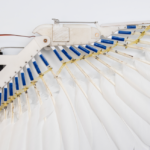News, What This PigeonBot Tells Us About the Future of Flight
Lentink’s team turned to the humble pigeon in order to discover these secrets of avian flight. “[They’re] under-appreciated fliers,” Lentink told Popular Mechanics. In a report published in Science Robotics, Lentink and his team discovered that pigeons—as well as most other flying birds—do not use individual muscles to control each of their feathers, but instead move them in sync, in groups, with the help of a special ligament. “What we discovered is that instead of a bird moving each and every feather, controlled by a muscle, they combine the motion of feathers,” he says. “It’s really elegant.” Knowing this, scientists built a robotic bird, called PigeonBot, to exhibit this property of bird wings. One day, small aircraft like drones could take advantage of this natural design.
Learn about our two Decals!
 Click here to find out more about our Fall Bioinspired Design Decal and our Spring Bioinspired Design in Action Decal – ALL MAJORS are welcome.
Click here to find out more about our Fall Bioinspired Design Decal and our Spring Bioinspired Design in Action Decal – ALL MAJORS are welcome.Berkeley BioDesign Community
 Click here to learn about the BioD: Bio-Inspired Design @ Berkeley student organization or here to signup for more info.
Click here to learn about the BioD: Bio-Inspired Design @ Berkeley student organization or here to signup for more info.Search
Student Login




I imagine that the neurological circuits underlying these processes are governed by both 2d spacing maps with their brains as…
to reduce the impact of car accidents, it may be possible to study the force diverting physics of cockroaches to…
you see this type of head-bobbing stability in many avian creatures related to pigeons like chickens. the head ability to…
not like they taught horses how to run! this is an example of convergent evolution where both sea creatures and…
The brain functions in a similar way with neuronal connections. our brains are able to utilize the multiplicity of connections…